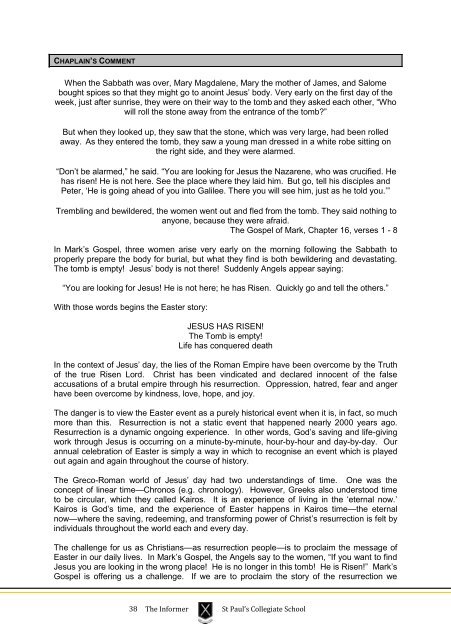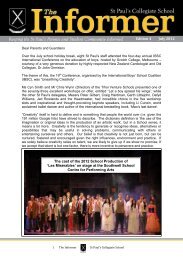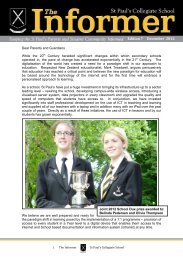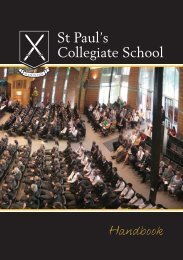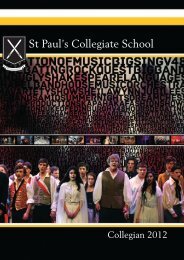Informer Edition 2 April 2013 - St Paul's Collegiate School
Informer Edition 2 April 2013 - St Paul's Collegiate School
Informer Edition 2 April 2013 - St Paul's Collegiate School
You also want an ePaper? Increase the reach of your titles
YUMPU automatically turns print PDFs into web optimized ePapers that Google loves.
CHAPLAIN’S COMMENT<br />
When the Sabbath was over, Mary Magdalene, Mary the mother of James, and Salome<br />
bought spices so that they might go to anoint Jesus’ body. Very early on the first day of the<br />
week, just after sunrise, they were on their way to the tomb and they asked each other, “Who<br />
will roll the stone away from the entrance of the tomb?”<br />
But when they looked up, they saw that the stone, which was very large, had been rolled<br />
away. As they entered the tomb, they saw a young man dressed in a white robe sitting on<br />
the right side, and they were alarmed.<br />
“Don’t be alarmed,” he said. “You are looking for Jesus the Nazarene, who was crucified. He<br />
has risen! He is not here. See the place where they laid him. But go, tell his disciples and<br />
Peter, ‘He is going ahead of you into Galilee. There you will see him, just as he told you.’”<br />
Trembling and bewildered, the women went out and fled from the tomb. They said nothing to<br />
anyone, because they were afraid.<br />
The Gospel of Mark, Chapter 16, verses 1 - 8<br />
In Mark’s Gospel, three women arise very early on the morning following the Sabbath to<br />
properly prepare the body for burial, but what they find is both bewildering and devastating.<br />
The tomb is empty! Jesus’ body is not there! Suddenly Angels appear saying:<br />
“You are looking for Jesus! He is not here; he has Risen. Quickly go and tell the others.”<br />
With those words begins the Easter story:<br />
JESUS HAS RISEN!<br />
The Tomb is empty!<br />
Life has conquered death<br />
In the context of Jesus’ day, the lies of the Roman Empire have been overcome by the Truth<br />
of the true Risen Lord. Christ has been vindicated and declared innocent of the false<br />
accusations of a brutal empire through his resurrection. Oppression, hatred, fear and anger<br />
have been overcome by kindness, love, hope, and joy.<br />
The danger is to view the Easter event as a purely historical event when it is, in fact, so much<br />
more than this. Resurrection is not a static event that happened nearly 2000 years ago.<br />
Resurrection is a dynamic ongoing experience. In other words, God’s saving and life-giving<br />
work through Jesus is occurring on a minute-by-minute, hour-by-hour and day-by-day. Our<br />
annual celebration of Easter is simply a way in which to recognise an event which is played<br />
out again and again throughout the course of history.<br />
The Greco-Roman world of Jesus’ day had two understandings of time. One was the<br />
concept of linear time—Chronos (e.g. chronology). However, Greeks also understood time<br />
to be circular, which they called Kairos. It is an experience of living in the ‘eternal now.’<br />
Kairos is God’s time, and the experience of Easter happens in Kairos time—the eternal<br />
now—where the saving, redeeming, and transforming power of Christ’s resurrection is felt by<br />
individuals throughout the world each and every day.<br />
The challenge for us as Christians—as resurrection people—is to proclaim the message of<br />
Easter in our daily lives. In Mark’s Gospel, the Angels say to the women, “If you want to find<br />
Jesus you are looking in the wrong place! He is no longer in this tomb! He is Risen!” Mark’s<br />
Gospel is offering us a challenge. If we are to proclaim the story of the resurrection we<br />
38<br />
The <strong>Informer</strong><br />
<strong>St</strong> Paul’s <strong>Collegiate</strong> <strong>School</strong>


